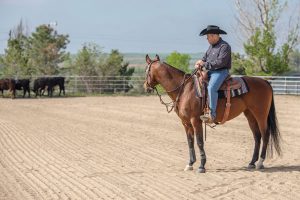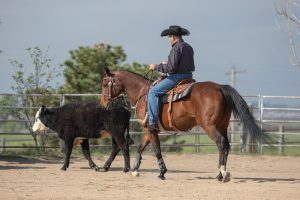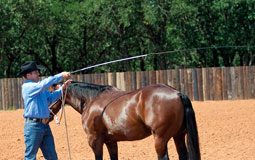
If you haven’t worked cattle before, you may envision the fast moves seen in the movies, like stunt doubles galloping to chase a steer separated from the herd. While the fast-paced rides can be fun, introducing your horse to cattle work shouldn’t include speed or anxiety. Instead, you’ll introduce your horse slowly while both of you remain relaxed.
“Take it slow,” he says. “You don’t want to put pressure on the horse or the cattle. Your only goal is to teach your horse to be comfortable and confident in the new cattle-filled environment. It doesn’t matter what work you accomplish in the pen at first. The horse has to have the confidence to know he can stop, control and move the cow around. If your horse lacks confidence, he’ll never be willing to step in front of the cow to stop him. You have to introduce the horse slowly to build his confidence so that you can one day add speed.”

Prep Work Before Introducing Your Horse to Cattle
Before your horse is ready for cow work, he must have a good stop, stand and turn. Take the time necessary to work on these skills before allowing your horse to approach cattle.
Martinez say you should be able to easily stop and back up without pulling excessively on the reins. Your horse should also know how to stand still in any environment. If a cow stops and stands, your horse must be able to stand, too.
Finally, your horse should know how to perform a rollback by shifting his weight back and moving his front legs around to change direction quickly.

Cattle Smarts
Before introducing your horse to cattle, be sure to work with a cattle pro to help make sure you introduce your horse to the right size and type of cattle. Start with only three or four cattle in a pen so that your horse isn’t overwhelmed.
If the cattle haven’t seen horses before, you won’t need to approach them closely to get them to move. If they’ve been used for cow work over and over, you may have to get closer to move them.
A New Rider
If you and your horse are both new to cattle work, consider asking a pro to get on and see how your horse reacts to the cattle. With a calm rider leading the way, your horse will more likely stay slow and quiet.
Take a lesson on a tried-and-true cow horse to learn what it feels like to ride a horse that will stay in control around the cattle. Set yourself up to feel confident and know that you’re in control. This helps you know what is involved in introducing your horse to cattle.
Martinez says that a finished cow horse should be responsive but not overly sensitive.
“He should do what I want when I want it, but he shouldn’t jump to the side if I use leg pressure,” he says. “The cow dictates the movements of the horse. If the cow jumps quickly to the side, a finished cow horse should move quickly, too. However, I don’t want my horse to jump if there’s no need. When I put a leg on a horse, I don’t want him to step off fast; I want him to step off and build up speed. If you get on a finished cow horse, you’ll feel that the horse is willing to stay quiet and relaxed. The misconception of thinking a cow horse will be hot and jittery goes away.”

Working Near the Herd
Make sure your horse is outfitted in a snaffle bit so that you can ride with two hands. You may choose to add a martingale for added control and to help remind your horse to keep his head down and relaxed.
While the cattle wait at one end of the arena, ignore them and warm up as you usually would. You’ll get your horse’s attention on you and show him that you are in control and the one to focus on no matter what else is close by.
Stop, back up, walk, trot and canter in both directions. Work slowly and stay relaxed. You’ll show your horse that he can follow your direction near the cattle.
Walk Up
Walk toward the herd in a slow, relaxed manner. Your only goal is to push the cattle around slowly. If the cattle want to trot a little, you can trot, too. Stop your horse and back up—just to make sure you still have control near the cattle.
if you and your horse are both new to cattle work, consider asking a pro to get on and see how your horse reacts to cattle.
If at any time your horse gets nervous, high-headed or jittery, redirect his attention. Ask him to turn around, walk away, or go work on another maneuver. You don’t have to stay focused on the cattle.
If your horse doesn’t want to get near the cattle at all, ask a friend (with a confident cow horse) to ride with you. When your friend rides with you, your horse will gain confidence and learn that he can approach just like the seasoned horse can.
Make sure your horse stays straight and moves in the straight line you pick out. Don’t allow him to move from right to left without authorization. Keep pushing the cattle around the arena while working at a relaxed, walking pace.
As the cattle settle and your horse gets more used to the new environment, you may be able to move closer to the herd. Approach more closely than you did as you first walked up and notice your horse’s reaction. If you need to stop or move away, that’s OK.
Keep in mind that it’s OK to walk around the herd and push it around for an entire session. If your horse is worried, it’s fine to leave it at that for your first day without moving on to the next step. You may just push the herd around for a half an hour and be done.
If your horse is relaxed and interested in the cattle (and continuously follows your directional cues), you can move on to the next step.

Pick One
Next, you’ll help your horse learn that he can move a cow away from the herd. He’ll gain confidence moving closer to the cows and he’ll learn that he can be between the herd and a single cow.
Ride toward the edge of the herd and see if one cow “peels off” easily. Don’t target one specific cow, you’ll just see which one is ready to leave the herd. Sort one off and ride a circle around the other cows to keep one away. You may work at the walk or trot.
If the cow moves away from the herd and adds speed, stay close to the herd and give the cow some work. When you keep your distance, you can maintain a slow gait without having to chase it. If you get close to the cow, he may move faster and your green horse won’t be ready for the speed.

Take a Break
If your horse gets excited, redirect his attention. Take him away from the cow and canter a few nice, controlled circles. Do something else if you’re getting nervous. Take a break, then return to work as many times as you need to keep your horse relaxed and focused on you.
Remember, there is no pressure. This is about teaching you and your horse to approach a cow. If you have to leave the cow and go lope circles for 10 minutes, that’s OK. Keep your cow work session to 20 to 25 minutes.
That doesn’t mean that your riding session is that short, but you only need to do 10 minutes of warm up, work cows for 10 minutes, work on maneuvers for 10 minutes, then
approach the cattle again.
Remember there is no pressure. this is about teaching you and your horse to approach a cow. If you have to leave the cow and go lope circles for 10 minutes, that’s ok.
“We don’t want to work our horses or our cattle too much,” Martinez says. “For my finished horses, I may go work one cow and be done with cattle work after four minutes and continue our workout doing other maneuvers. If I got the response I wanted, I don’t need to drill. I want to keep my horse interested and calm instead of pushing.”
Thanks to Gary Martinez for demonstrating these moves with a first-time cow horse, 4-year-old Half-Arabian GCA Smart Headlines.
Meet the TrainerTrainer Gary Martinez is a National Reined Cow Horse Association judge who holds national championships in cutting, reining, working cow horse, ranch pleasure and ranch riding. He coaches riders and trains horses in Fort Lupton, Colo. |
This article on introducing your horse to cattle originally appeared in the August 2019 issue of Horse Illustrated magazine. Click here to subscribe!





